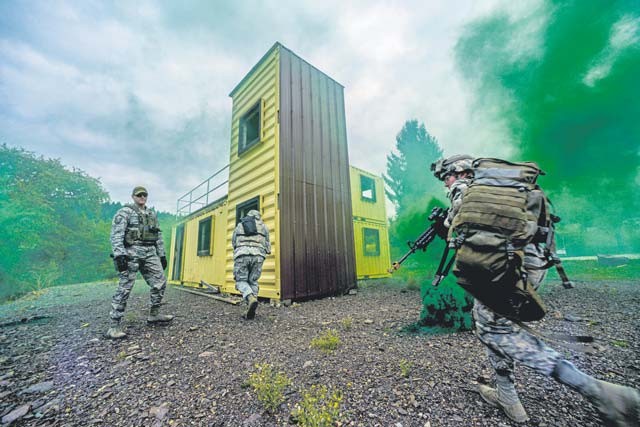
Through thick brush and hilly terrain, 25 security forces members from U.S. Air Forces in Europe and Air Forces Africa tactically maneuvered down a mountain before taking a village Sept. 26.
Law enforcement participated in a field training exercise, the final test after completing the 21-day Creek Defender course.
After the course, security forces members were placed in a training environment where they traveled two kilometers from their insertion point before putting their newly honed skills to the test.
The course involves two parts: one part for base security sensor operators and leaders, and a second part in which students learn dismounted and mounted patrols, land navigation, range estimation, weapons firing and tactical firing under stress.
Upon completion of the classroom portion, the defenders devised a plan to travel on foot and by vehicle from their insertion point to the village where they established a base operations center.
By using their maps and skills they acquired during the course, the defenders were able to make a thorough plan and meet their goal of taking the village, said Staff Sgt. Stephen Kraus, 435th Security Forces Squadron Ground Combat Regional Training Center instructor.
“Getting out here and seeing what we (teach students) put into action is like watching your kids grow up,” Kraus said. “For most cops, day-to-day operations differ from the combat skills used downrange.”
Many Airmen who participated in the course were training for their first deployment and were inexperienced with the skills that fall outside of their daily job descriptions such as recognizing unusual threats.
“This training has been extremely necessary,” said Senior Airman Kyle McDonnell, 86th Security Forces Squadron gate guard. “We don’t usually do these things in a normal day, so it changes our mindset to get us ready for deployment. When you aren’t in this environment and you drive down the road and see a dead animal in the street, you won’t think twice about it. Doing this type of training prepares you for those red flags you wouldn’t normally look for when those threats are present.”
Given that classes are usually comprised of more than 100 students at a time, the instructors said it was a nice change for them to have more interaction with individual students.
“Since we only had 25 students, it allowed us to get much more in depth with hands-on training.” Kraus said.
The Creek Defender course is offered more than seven times a year to keep Airmen ready for situations they could face when deploying downrange.


